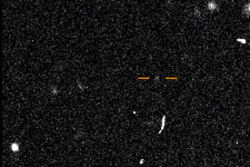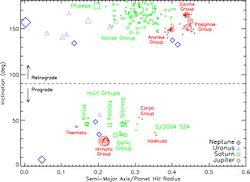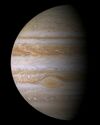Astronomy:Valetudo (moon)
 Precovery images of Valetudo taken by the Canada-France-Hawaii Telescope on 28 February 2003 | |
| Discovery[1] | |
|---|---|
| Discovered by | Scott S. Sheppard et al. |
| Discovery site | Las Campanas Obs. |
| Discovery date | 9 March 2016 |
| Designations | |
Designation | Jupiter LXII |
| Pronunciation | /væləˈtjuːdoʊ/ |
| Named after | Valētūdo |
| S/2016 J 2 | |
| Adjectives | Valetudian |
| Orbital characteristics [2] | |
| Epoch 17 December 2020 (JD 2459200.5) | |
| Observation arc | 15.22 yr (5,558 d) |
| Earliest precovery date | 26 February 2003 |
| 0.1257974 AU (18,819,020 km) | |
| Eccentricity | 0.2018315 |
| Orbital period | +1.44 yr (+527.41 d) |
| Mean anomaly | 201.41718° |
| Mean motion | 0° 40m 57.274s / day |
| Inclination | 32.03294° (to the ecliptic) |
| Longitude of ascending node | 235.45916° |
| 122.37546° | |
| Satellite of | Jupiter |
| Group | (own group) |
| Physical characteristics | |
| Mean diameter | 1 km[3] |
| Apparent magnitude | 24.0[3] |
| Absolute magnitude (H) | 17.0 |
Valetudo /væləˈtjuːdoʊ/, also known as Jupiter LXII and originally known as S/2016 J 2, is an irregular moon of Jupiter. It was discovered by Scott S. Sheppard and his team in data acquired by the 6.5-m Magellan-Baade telescope of the Las Campanas Observatory in 2016, but was not announced until 17 July 2018, via a Minor Planet Electronic Circular from the Minor Planet Center, which also reported the discovery of nine other of Jupiter's moons.[1] Besides data from Las Campanas, the original announcement also referred to data acquired through the 8.1-m Gemini North telescope of the Mauna Kea Observatories as well as the 4.0-m reflector of the Cerro Tololo Inter-American Observatory.[4]
Characteristics

Valetudo has a diameter of about 1 km (0.6 mi) and orbits Jupiter at a distance of about 19 million kilometres (12 million miles). Its orbital inclination is 34 degrees, and its orbital eccentricity is 0.222.[3] It has a prograde orbit which takes almost a year and a half to complete, but it crosses paths with several other moons that have retrograde orbits and may in the future collide with them.[6]
Name
The moon was provisionally designated as S/2016 J 2 until it received its name in 2018. Sheppard proposed the name Valetudo, after the Roman goddess of health and hygiene (a Latin translation of Greek Hygieia 'Health') and a great-granddaughter of the god Jupiter. The name also alluded to Sheppard's girlfriend, whom he joked about being cleanly.[7] The name conforms with the naming conventions for Jupiter moons set out by the International Astronomical Union (IAU), according to which a name ending in -o indicates a high inclination.[8] The name was approved by the IAU Working Group for Planetary System Nomenclature on 3 October 2018.[9]
References
- ↑ 1.0 1.1 "MPEC 2018-O09 : S/2016 J 2". International Astronomical Union. https://minorplanetcenter.net/mpec/K18/K18O09.html.
- ↑ "M.P.C. 128893". Minor Planet Circular. Minor Planet Center. 27 January 2021. https://minorplanetcenter.net/iau/ECS/MPCArchive/2021/MPC_20210127.pdf. Retrieved 23 February 2021.
- ↑ 3.0 3.1 3.2 Sheppard, Scott S.. "Moons of Jupiter". https://sites.google.com/carnegiescience.edu/sheppard/moons/jupitermoons.
- ↑ "A dozen new moons of Jupiter discovered, including one "oddball"". Earth & Planets Laboratory. Carnegie Institution for Science. 16 July 2018. https://carnegiescience.edu/dozen-new-moons-jupiter-discovered-including-one-oddball. Retrieved 29 January 2023.
- ↑ Sheppard, Scott S.; Tholen, David J.; Alexandersen, Mike; Trujillo, Chadwick A. (24 May 2023). "New Jupiter and Saturn Satellites Reveal New Moon Dynamical Families". Research Notes of the AAS 7 (5): 100. doi:10.3847/2515-5172/acd766.
- ↑ Strickland, Ashley. "12 new moons discovered around Jupiter". CNN International (CNN). https://edition.cnn.com/2018/07/17/us/jupiter-12-new-moons/index.html.
- ↑ Carlson, Erika K. (17 July 2018). "Jupiter's Got Twelve New Moons — One is a Bit of a Problem Child". Discover Magazine. https://www.discovermagazine.com/the-sciences/jupiters-got-twelve-new-moons-one-is-a-bit-of-a-problem-child. Retrieved 29 January 2023.
- ↑ Antonietta Barucci, M. (2008). "Irregular Satellites of the Giant Planets". The Solar System Beyond Neptune. p. 414. ISBN 9780816527557. http://home.dtm.ciw.edu/users/sheppard/pub/Nicholson2008KBOBook.pdf. Retrieved 17 July 2022.
- ↑ USGS Astrogeology Science Center, Nomenclature News: Name Approved for Jovian Satellite: Valetudo
 |


